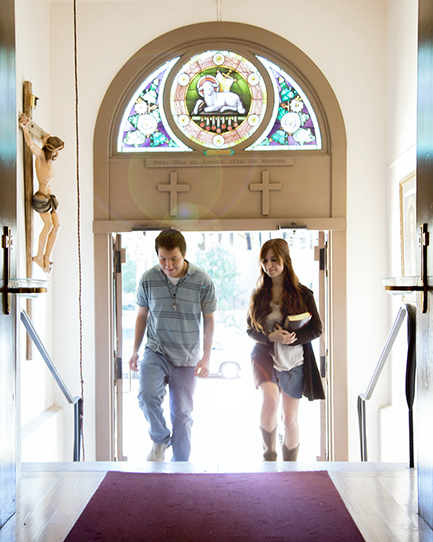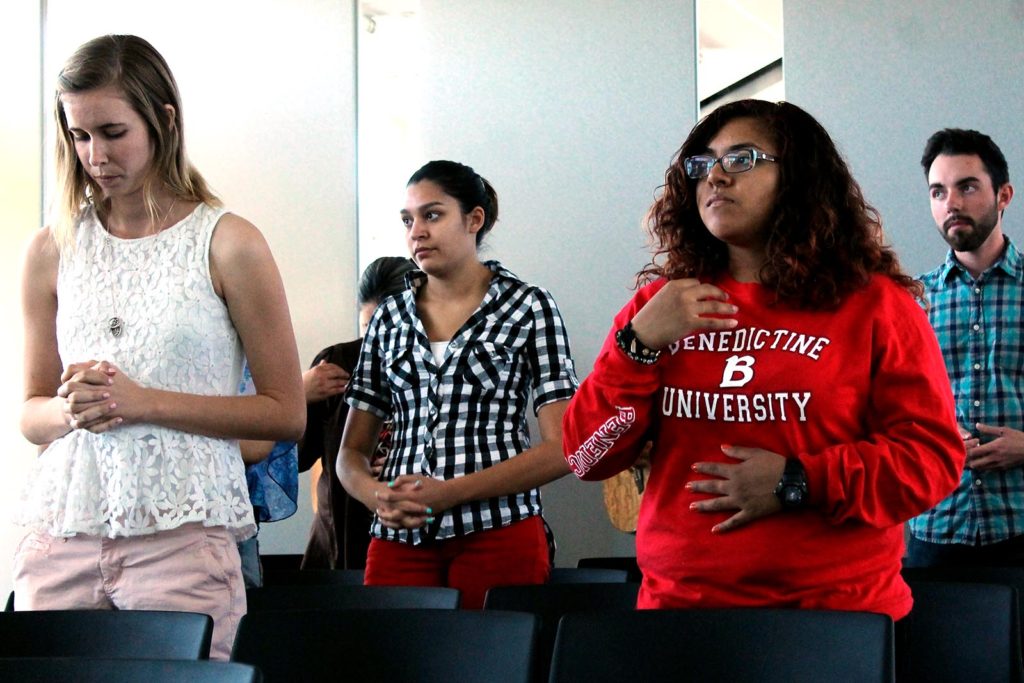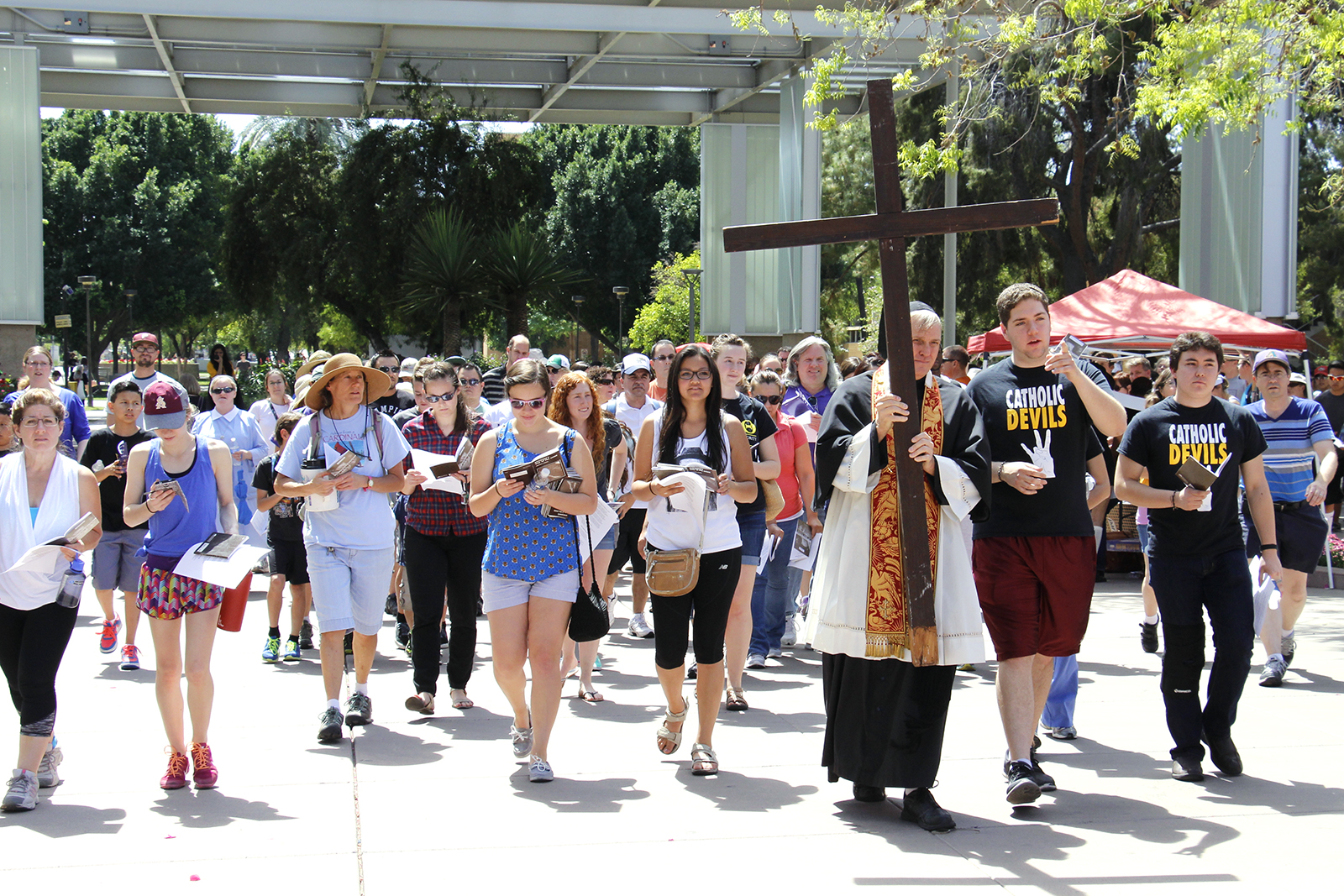College students have a champion in Bishop Thomas J. Olmsted. He envisioned a stronger future for college-aged adults by designating $10 million from the “Together Let Us Go Forth ~ Juntos Sigamos Adelante” campaign to the Newman Centers serving Arizona State University, Northern Arizona University and Grand Canyon University.
The bishop also wrote a pastoral letter with them in mind.
“Serving the Truth in the University” turns 10 this December. The letter calls for Catholic Newman Centers — named for the recently canonized cardinal who emphasized the importance of spiritual growth among college students — to provide a visible witness of the faith, have a mission of proclamation and conversion and offer ongoing conversion, especially via sacramental life.
It’s something the Newman Centers serving college-aged students in the diocese have done since their inception. The Newman Centers at NAU in Flagstaff and ASU in Tempe date back to the 1930s. A small “Newman Club” launched at ASU’s Polytechnic campus in 2006 and has small, fluctuating numbers at the commuter campus. The “freshman” Holy Spirit Newman Center at GCU emerged in 2016.
Regardless of when they were established, each one strives to keep students involved in parish life far into adulthood by empowering them to nurture an ongoing relationship with Christ.
Newman Centers
“A Newman Center complements the pursuit of knowledge and truth with the proclamation of the Good News,” Bishop Olmsted wrote in his pastoral letter. A Newman Center promotes “the vital interaction between faith and reason, the two harmonious ways to the truth, which is always one,” he continued citing Ex Corde Ecclesiae, an apostolic constitution St. John Paul II wrote regarding Catholic colleges and universities.
Much like the Church in general, the bishop’s letter said evangelization takes place through visible witness, namely in the liturgy. For decades, the Sunday evening Masses at All Saints Newman Center in Tempe have been well attended — and dubbed the “Last call” Mass.
The Holy Spirit Newman Center at GCU, now in its fourth year, added a second Sunday Mass last month. Some 80-100 students attend; the chapel seats 50.
“We have overflow at every Mass with students sitting in the Newman Center living room, watching the Mass live on our TV,” explained campus missionary Marian Escio.
Students nearly fill the chapel for Wednesday evening Mass. The liturgy is the key offering that keeps students engaged and diving deeper into their faith, Escio said. “Newman Nights” on Thursdays offer fellowship, guest speakers, prayer nights and free food.
These two outreaches, Mass and community, summarize a Newman Center. “By offering what little we have to the Lord, He has amazed us and has blessed us back abundantly. He continues to amaze me each and every day,” Escio said.
Bible studies and missionary opportunities are also associated with Newman Centers as are leadership opportunities. Some 17 Holy Trinity Newman Center alumni alone have moved on to become FOCUS missionaries.
Sarina Stokes, a recent NAU graduate, among them, described the Newman Center as a place of unconditional love, first from its chaplain, “who, like our Father in Heaven, pours it into his flock of children, the students. Because of this example from him, it is then reflected into the community of students and they begin to love and care for each other.”
Some college Catholics serve as interns and student leaders at their respective Newman Center. Esco described their role as one of welcoming, including to those of other faiths.
“They have a distinct opportunity to share with newcomers their love for the Lord and their Catholic faith. They are becoming more knowledgeable about the different faces of Catholicism and the different ways of leading people to the Lord,” Esco said. She sees interns growing in their responsibilities and their ability to manage their time and tasks while still being engaged with others.
The number of student leaders grew exponentially at All Saints in the last three years. Generations of musicians have come out of them as well.
Fr. Rob Clements from All Saints Newman Center sees great numbers of students who count on the availability of the sacraments, short courses and formation opportunities.
“I’m excited we’re making more of an impact in directly reaching out to students on campus and encouraging even those students with little religious affiliation to search for God, to ask intelligent questions, to experience the beauty and dynamism that life in Christ provides us,” Fr. Clements said.
Catholic institutions

Another way students can do that is through formal Catholic higher education. The University of Mary was the first to successfully launch a satellite campus in the Diocese of Phoenix. Mary College at ASU, as the satellite campus is now known, opened in 2012 and allows students at two universities to take advantage of its Catholic Studies program, one of its fastest-growing tracks.
Students from University of Mary’s main campus in North Dakota attend Mary College at ASU as part of a domestic exchange. It gives North Dakota students, particularly freshmen, a chance to move off the waiting list and enjoy a semester at ASU. ASU students can take Mary College classes too. Everyone maintains their respective tuition, and everything transfers. There have been 32 graduates to date with many more taking classes without degree recognition.
“That’s been a fantastic opportunity of vitality, of life, of culture and of faith,” said Msgr. James Shea, University of Mary president. What’s more, the classes teach from the Catholic perspective, yet fulfill ASU requirements in history, language arts and more.
Jonathon Hofer, program coordinator for Mary College at ASU put it another way. “You can have a robust Catholic academic and spiritual experience all while attending a major university,” he said. Hofer also facilitates one of two tutorial sessions. The one-credit course fosters discussion among small groups aimed at synthesizing and applying their academics to real life and other disciplines.
Mary College events include the weekly Convivium after an evening Mass where students hear informally from a guest speaker or have a more formal lecture. Disputacio sessions foster discourse and is modeled after St. Thomas Aquinas’ Summa Theologica.
A few miles east in Mesa, Benedictine University set up a full campus in 2013 and now welcomes 571 students from 23 states and six countries on campus. Some 51 of them live in nearby student housing. Another 398 have graduated.


Rob Curtis, director of campus ministry, reflected on the Benedictine hallmark of conversatio, or the way of formation and transformation in academic and co-curricular programming. He sees students take time to discern a major and life’s next steps. One student has already discerned religious life, at least six sacramental marriages and at least six alumni serve the Church as lay ministers.
Curtis also sees the Benedictine hallmark of hospitality in the faith, ethnic, cultural and socio-economic backgrounds on campus. DACA students have found a home there and those without a faith affiliation also find a chance to explore the spiritual dimension.
Creighton University, a Jesuit university in Nebraska, has operated a health sciences program in Phoenix for more than a decade. Partnerships with St. Joseph Hospital and the Foundation for Senior Living for internships have further trained upper division students. A new building slated to open in 2021 will bring underclassmen here and up to 900 students studying and largely remaining in a diocese whose health care needs continually increase at a rapid rate.






